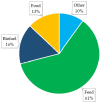Recent Research on Fusarium Mycotoxins in Maize-A Review
- PMID: 36360078
- PMCID: PMC9659149
- DOI: 10.3390/foods11213465
Recent Research on Fusarium Mycotoxins in Maize-A Review
Abstract
Maize (Zea mays L.) is one of the most susceptible crops to pathogenic fungal infections, and in particular to the Fusarium species. Secondary metabolites of Fusarium spp.-mycotoxins are not only phytotoxic, but also harmful to humans and animals. They can cause acute or chronic diseases with various toxic effects. The European Union member states apply standards and legal regulations on the permissible levels of mycotoxins in food and feed. This review summarises the most recent knowledge on the occurrence of toxic secondary metabolites of Fusarium in maize, taking into account modified forms of mycotoxins, the progress in research related to the health effects of consuming food or feed contaminated with mycotoxins, and also the development of biological methods for limiting and/or eliminating the presence of the same in the food chain and in compound feed.
Keywords: Fusarium; biological methods; classification; detoxification; maize; modified mycotoxins; mycotoxins; occurrence; toxicology.
Conflict of interest statement
The authors declare no conflict of interest.
References
-
- Soto-Gómez D., Pérez-Rodríguez P. Sustainable agriculture through perennial grains: Wheat, rice, maize, and other species. A review. Agric. Ecosyst. Environ. 2022;325:107747. doi: 10.1016/j.agee.2021.107747. - DOI
-
- OECD-FAO . Agricultural Outlook 2022–2031. OECD-FAO; Rome, Italy: Paris, France: 2022. - DOI
-
- Liliane T., Mutengwa C. Factors Affecting Yield of Crops, Agronomy—Climate Change & Food Security. IntechOpen; Amanullah, Afghanistan: 2020. [(accessed on 14 September 2022)]. Available online: https://www.intechopen.com/books/agronomy-climate-change-food-security/f....
Publication types
Grants and funding
LinkOut - more resources
Full Text Sources
Miscellaneous


